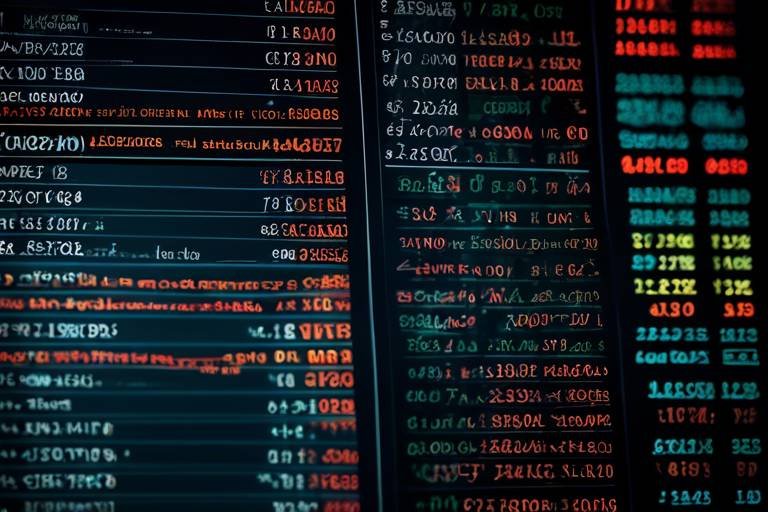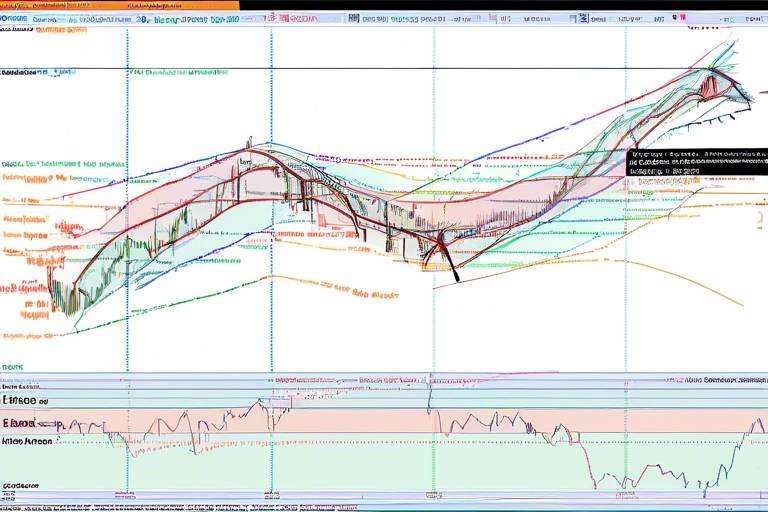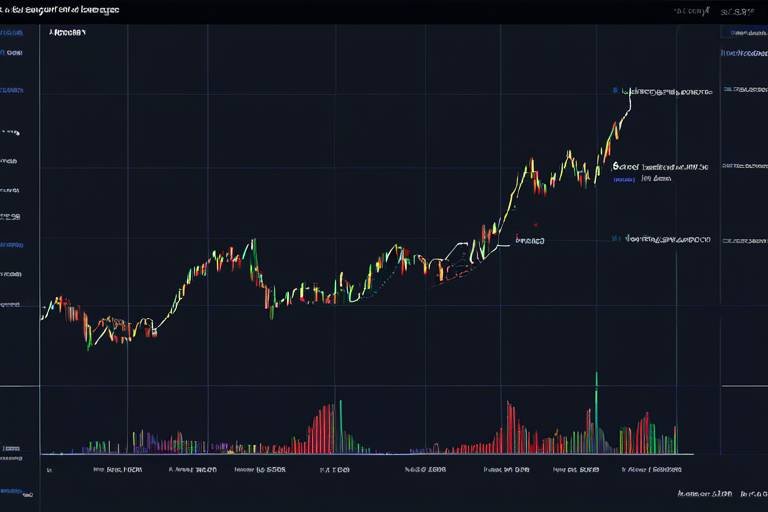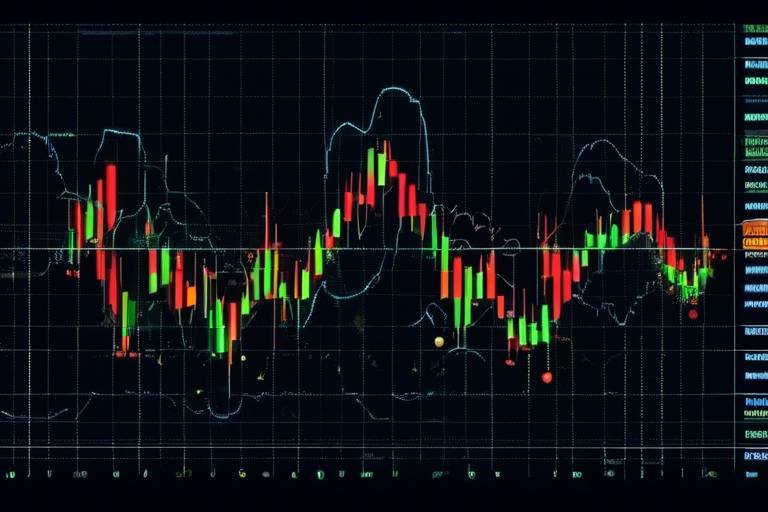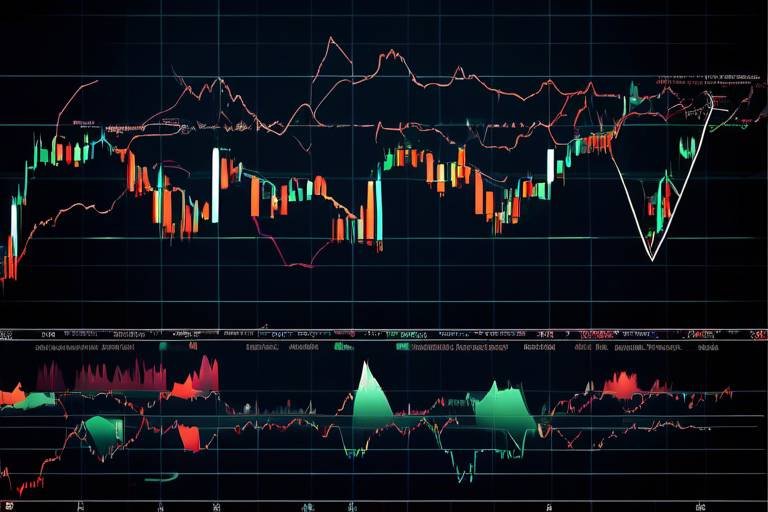How to Analyze Cryptocurrency Market Conditions
In the ever-evolving world of cryptocurrency, understanding how to analyze market conditions is not just a skill; it’s an essential tool for anyone looking to invest wisely. Imagine standing on the edge of a vast ocean, with waves of data crashing around you. Each wave represents market trends, technical indicators, and fundamental factors that can either lift you to new heights or pull you under. This article will guide you through the various methods and tools available for analyzing cryptocurrency market conditions, ensuring you are well-equipped to make informed decisions based on the latest market trends.
First, let’s talk about the importance of market trends. Recognizing whether the market is in a bullish (upward) or bearish (downward) phase is crucial. Just like a seasoned surfer knows when to catch the right wave, investors must analyze historical data and price movements to identify these trends. For instance, a consistent increase in prices over a period might indicate a bullish trend, while a series of declining prices could suggest a bearish market. By understanding these trends, you can position yourself strategically in the market.
Next up is the realm of technical analysis tools. These tools, such as charts and indicators, serve as your navigational instruments in the tumultuous sea of cryptocurrency trading. Popular tools like moving averages and the Relative Strength Index (RSI) can provide valuable insights. For example, moving averages smooth out price data to help you identify the direction of the trend, while the RSI can signal whether a cryptocurrency is overbought or oversold. Together, they can enhance your decision-making process and help you ride the waves of the market more effectively.
Identifying market trends is crucial for cryptocurrency analysis. This section discusses how to recognize bullish and bearish trends using historical data and price movements.
Technical analysis tools, such as charts and indicators, are essential for evaluating market conditions. Here, we review popular tools like moving averages and RSI to aid decision-making.
Chart patterns provide visual insights into market behavior. This subsection explains common patterns like head and shoulders, flags, and triangles that can signal potential price movements.
Understanding support and resistance levels is vital for traders. This part covers how to identify these levels and their significance in predicting price reversals.
Volume analysis complements price movements. This section highlights how trading volume can indicate the strength of a trend and potential market reversals.
Indicators and signals help traders make informed decisions. This subsection focuses on key indicators like MACD and Bollinger Bands, explaining their roles in market analysis.
Fundamental analysis assesses the intrinsic value of cryptocurrencies. This section delves into factors like technology, team, and market demand that influence cryptocurrency valuations.
The regulatory environment significantly impacts cryptocurrency markets. This part discusses how government regulations and legal frameworks can affect market conditions and investor sentiment.
Market sentiment reflects the overall attitude of investors toward a cryptocurrency. This subsection explores tools and methods for gauging sentiment, including social media and news analysis.
Effective risk management is vital in cryptocurrency trading. This section outlines strategies to minimize losses and maximize gains, ensuring a balanced investment approach.
Diversification can mitigate risks in cryptocurrency investments. This part discusses methods for spreading investments across various cryptocurrencies to enhance portfolio stability.
Stop-loss orders protect against significant losses. This subsection explains how to set effective stop-loss levels based on market conditions and personal risk tolerance.
1. What is the best way to analyze cryptocurrency market conditions?
The best way to analyze cryptocurrency market conditions is by combining technical analysis tools, understanding market trends, and considering fundamental factors. This multifaceted approach will give you a well-rounded view of the market.
2. How do I know when to buy or sell a cryptocurrency?
You can determine when to buy or sell by analyzing market trends, using technical indicators, and observing volume changes. Additionally, setting clear goals and risk management strategies will help you make informed decisions.
3. Why is risk management important in cryptocurrency trading?
Risk management is crucial because the cryptocurrency market is highly volatile. Implementing strategies such as diversification and setting stop-loss orders can help protect your investments from significant losses.

Understanding Market Trends
When it comes to the world of cryptocurrency, understanding market trends is like having a compass in a dense forest. Without it, you might find yourself lost amidst the chaos of price fluctuations and market sentiment. So, how do we identify these trends? It all starts with recognizing the two main directions the market can take: bullish and bearish. A bullish trend indicates that prices are rising, while a bearish trend suggests they are falling. But how do we spot these trends in the wild?
One effective method is to analyze historical data and price movements. By looking back at how a cryptocurrency has performed over time, we can gain insights into its potential future behavior. For instance, if a coin has consistently increased in value over several months, we might conclude that it is in a bullish trend. Conversely, if the price has been declining, it may be a sign of a bearish trend.
Another important aspect of trend analysis is the use of charts. Charts provide a visual representation of price movements and can help identify patterns that may not be immediately obvious. For example, a line chart can show the overall direction of a cryptocurrency's price over time, while a candlestick chart can reveal more detailed information about price movements within specific time frames.
To further aid in our understanding of market trends, we can utilize various technical analysis tools. These tools, such as moving averages and the Relative Strength Index (RSI), allow us to gauge the strength of a trend. For example, when the price of a cryptocurrency crosses above its moving average, it could signal a potential upward trend. On the other hand, if the RSI indicates that a cryptocurrency is overbought, it might suggest that a bearish trend is on the horizon.
It's also essential to keep an eye on market sentiment. This refers to the overall attitude of investors towards a particular cryptocurrency. Are they feeling optimistic or pessimistic? Tools like social media sentiment analysis and news monitoring can provide valuable insights into how investors are feeling, which can significantly influence market trends.
In summary, understanding market trends is a multifaceted approach that combines historical data analysis, charting techniques, technical analysis tools, and market sentiment evaluation. By mastering these elements, investors can make more informed decisions and potentially increase their chances of success in the ever-changing world of cryptocurrency.

Technical Analysis Tools
When diving into the world of cryptocurrency trading, having the right tools at your disposal can make all the difference. are essential for evaluating market conditions, predicting future price movements, and making informed decisions. These tools allow traders to interpret price data, identify patterns, and gauge market sentiment, which is crucial in such a volatile environment. Let’s explore some of the most popular tools that can enhance your trading strategy.
One of the most fundamental tools in technical analysis is the chart. Charts visually represent price movements over time, enabling traders to spot trends and patterns. There are various types of charts, including line charts, bar charts, and candlestick charts. Each type offers different insights, but candlestick charts are particularly favored in the crypto community due to their ability to convey more information, such as opening, closing, high, and low prices within a specific time frame.
Alongside charts, indicators play a pivotal role in technical analysis. These mathematical calculations are based on price and volume data, helping traders identify potential entry and exit points. Some of the most widely used indicators include:
- Moving Averages (MA): These smooth out price data to identify trends over a specific period, making it easier to determine the direction of the market.
- Relative Strength Index (RSI): This momentum oscillator measures the speed and change of price movements, helping traders identify overbought or oversold conditions.
- Moving Average Convergence Divergence (MACD): This indicator shows the relationship between two moving averages of a security’s price, providing insights into momentum and trend direction.
Another critical aspect of technical analysis is understanding chart patterns. These patterns, formed by price movements on a chart, can indicate potential future price action. For instance:
| Pattern | Description |
|---|---|
| Head and Shoulders | A reversal pattern that signals a change in trend direction. |
| Flags | A continuation pattern that suggests a brief pause before the previous trend resumes. |
| Triangles | These can be ascending, descending, or symmetrical and indicate potential breakout points. |
Additionally, understanding support and resistance levels is vital for traders. Support levels are price points where a downtrend can be expected to pause due to a concentration of demand, while resistance levels are where an uptrend can stall due to a concentration of selling interest. Recognizing these levels can help traders make better decisions about when to enter or exit a position.
Lastly, volume analysis is another essential tool in technical analysis. Volume refers to the number of coins traded within a specific timeframe. High trading volume typically indicates strong interest in a particular cryptocurrency, suggesting that a price movement is likely to continue. Conversely, low volume may indicate a lack of interest, which could lead to price reversals. By analyzing volume alongside price movements, traders can gain a clearer picture of market dynamics.
In summary, utilizing technical analysis tools can significantly enhance your trading strategy in the cryptocurrency market. By combining charts, indicators, patterns, support and resistance levels, and volume analysis, traders can make more informed decisions and navigate the complexities of this fast-paced environment.
Q1: What is the best technical analysis tool for beginners?
A1: For beginners, starting with simple tools like moving averages and candlestick charts can be very effective. They provide clear insights without overwhelming complexity.
Q2: How often should I analyze the market?
A2: It depends on your trading style. Day traders may analyze the market multiple times a day, while long-term investors might do so weekly or monthly.
Q3: Can technical analysis predict market movements accurately?
A3: While technical analysis can provide valuable insights, it’s not foolproof. Market conditions can change rapidly, so it's best used in conjunction with other analysis methods.

Chart Patterns
Chart patterns are like the fingerprints of market behavior—they tell us a story about what has happened and what might happen next. By recognizing these patterns, traders can make more informed decisions, almost like having a crystal ball for predicting price movements. Some of the most common chart patterns include head and shoulders, flags, and triangles. Each of these patterns has its own unique implications for future price action.
Let’s take a closer look at these patterns:
- Head and Shoulders: This pattern typically indicates a reversal in trend. It consists of three peaks: a higher peak (head) between two lower peaks (shoulders). When the price breaks below the neckline, it often signals a bearish trend.
- Flags: Flags are continuation patterns that indicate a brief pause in the prevailing trend. They look like a small rectangle that slopes against the trend. After a breakout from the flag, the price usually continues in the direction of the prior trend.
- Triangles: Triangles can be ascending, descending, or symmetrical, and they often signal a period of consolidation before a breakout. The price action narrows over time, and traders watch for a breakout above or below the triangle to determine the next move.
Understanding these patterns can significantly enhance your trading strategy. For instance, the head and shoulders pattern can be particularly valuable for identifying potential reversals, allowing traders to exit positions or enter new ones with greater confidence. On the other hand, flags can help traders stay in a trend longer, maximizing potential profits.
In addition to recognizing these patterns, it’s crucial to consider the context in which they appear. The strength of a pattern can be influenced by other factors such as volume and market sentiment. For example, a head and shoulders pattern accompanied by high trading volume may suggest a stronger reversal signal compared to one with low volume.
To help visualize these patterns, here’s a simple table summarizing their characteristics:
| Chart Pattern | Type | Implication |
|---|---|---|
| Head and Shoulders | Reversal | Bearish trend signal |
| Flags | Continuation | Trend continuation signal |
| Triangles | Consolidation | Potential breakout direction |
In conclusion, chart patterns are invaluable tools for traders looking to navigate the often turbulent waters of the cryptocurrency market. By familiarizing yourself with these patterns and understanding their implications, you can enhance your trading strategy and improve your chances of success. Remember, though, that no pattern is foolproof; always combine your analysis with other tools and strategies for the best results.
What are chart patterns?
Chart patterns are formations created by the movement of prices on a chart, which can indicate potential future price movements.
How can I identify chart patterns?
By studying price charts and looking for specific formations such as head and shoulders, flags, and triangles, traders can identify chart patterns.
Are chart patterns reliable?
While chart patterns can provide valuable insights, they are not guaranteed indicators. It's important to use them in conjunction with other analysis tools.

Support and Resistance Levels
Understanding is vital for traders navigating the often tumultuous waters of cryptocurrency markets. These levels serve as psychological barriers where price movements tend to pause or reverse. Think of support levels as the floor of a room; they prevent the price from falling below a certain point. Conversely, resistance levels act like a ceiling, capping the price from rising too high. Recognizing these levels can be a game-changer for your trading strategy.
To identify these levels, traders often look at historical price data. A support level is identified when the price has previously bounced back after hitting a certain low, while a resistance level is marked when the price has failed to break through a high point multiple times. The more times a price level is tested, the stronger it becomes. For instance, if a cryptocurrency repeatedly bounces off a support level of $50, traders may view this as a strong indicator that the price is unlikely to fall below this point in the near future.
Here's a quick breakdown of how to identify these crucial levels:
- Historical Data Analysis: Review past price movements to spot levels where the price has consistently reversed.
- Trend Lines: Draw lines connecting the highs or lows on a price chart to visualize potential support and resistance areas.
- Volume Profile: Analyze trading volume at different price levels to see where significant buying or selling has occurred.
Once identified, these levels can be used strategically. For example, if a trader sees that a cryptocurrency is approaching a resistance level, they might choose to sell or short the asset, anticipating a price drop. On the flip side, if the price approaches a support level, it could be an ideal time to buy, as the price may bounce back upwards.
However, it's essential to remember that support and resistance levels are not foolproof. Market conditions can change rapidly due to various factors, including news events or shifts in investor sentiment. Therefore, always combine this analysis with other tools, such as technical indicators, to make more informed trading decisions.
In summary, support and resistance levels are indispensable tools in a trader's arsenal. They help in making educated guesses about future price movements and can significantly improve trading strategies when used correctly. By paying attention to these levels, you can enhance your ability to anticipate market trends and position yourself for success in the dynamic world of cryptocurrency trading.
What are support and resistance levels?
Support levels are price points where a cryptocurrency tends to stop falling and may bounce back up, while resistance levels are points where the price tends to stop rising and may fall back down.
How do I identify support and resistance levels?
You can identify these levels by analyzing historical price data, drawing trend lines, and examining trading volume at different price points.
Can support and resistance levels change?
Yes, support and resistance levels can change due to market dynamics, news events, or shifts in investor sentiment. Always stay updated and adjust your strategies accordingly.
Should I rely solely on support and resistance levels?
While they are important, it's best to use support and resistance levels in conjunction with other technical analysis tools and indicators for a more comprehensive trading strategy.

Volume Analysis
When diving into the world of cryptocurrency trading, one of the key aspects that often gets overlooked is . You might be wondering, "Why should I care about volume?" Well, think of trading volume as the heartbeat of the market. Just like a doctor checks your pulse to understand your health, traders analyze volume to gauge the strength of price movements. High trading volume typically indicates strong interest and commitment from investors, while low volume can suggest a lack of enthusiasm or uncertainty about price direction.
So, how can you effectively analyze volume in the cryptocurrency markets? First, it's essential to understand that volume is not just a number; it tells a story. For instance, if the price of a cryptocurrency is rising but the volume is falling, it could be a sign that the upward trend lacks strength. Conversely, a price increase accompanied by high volume usually signals a robust bullish trend, indicating that many traders are buying in, believing in the asset's potential.
To illustrate this concept, let’s take a look at a simple table that showcases different scenarios of price movements and their corresponding volume levels:
| Price Movement | Volume Level | Market Sentiment |
|---|---|---|
| Price Increase | High | Strong Bullish Sentiment |
| Price Increase | Low | Weak Bullish Sentiment |
| Price Decrease | High | Strong Bearish Sentiment |
| Price Decrease | Low | Weak Bearish Sentiment |
As seen in the table, the relationship between price movements and volume can help traders make more informed decisions. For example, if you're observing a price increase with low volume, it might be wise to hold off on making a purchase, as the upward trend could quickly reverse. On the flip side, if you see a price increase alongside high volume, that could be a green light to enter the market.
Additionally, volume analysis can help identify potential market reversals. For instance, if a cryptocurrency has been in a downtrend but suddenly experiences a spike in volume, it may indicate that buyers are stepping in, possibly signaling a reversal. This is where the old saying, "Volume precedes price," comes into play. By paying attention to volume, you can often spot trends before they fully materialize, giving you an edge over other traders.
Remember, volume analysis is not just a standalone tool; it's most effective when combined with other technical analysis methods. By integrating volume analysis with indicators like moving averages or RSI, you can create a more comprehensive view of the market. This multi-faceted approach allows you to make decisions based on a broader set of data, increasing your chances of success in the volatile world of cryptocurrency trading.
In conclusion, understanding volume analysis is crucial for anyone looking to navigate the cryptocurrency market effectively. It provides valuable insights into market sentiment and can help you make more informed trading decisions. So, the next time you're evaluating a cryptocurrency, take a moment to consider its volume—after all, it could be the key to unlocking your trading potential!

Indicators and Signals
When diving into the world of cryptocurrency trading, serve as your compass, guiding you through the turbulent seas of market volatility. These tools help traders make informed decisions by providing insights into potential future price movements. Just like a weather forecast can help you decide whether to carry an umbrella, these indicators can suggest whether it’s a good time to buy or sell your assets.
Two of the most popular indicators in the cryptocurrency realm are the Moving Average Convergence Divergence (MACD) and Bollinger Bands. The MACD is particularly useful for identifying the momentum of a cryptocurrency. It consists of two moving averages that help traders spot potential buy and sell signals. When the MACD line crosses above the signal line, it often indicates a bullish trend, whereas a cross below may suggest a bearish trend.
On the other hand, Bollinger Bands provide a visual representation of volatility. They consist of a middle band (the moving average) and two outer bands that are standard deviations away from the average. When the price touches the upper band, it may signal that the asset is overbought, while touching the lower band can indicate that it’s oversold. This can help traders make decisions about entering or exiting positions.
To further enhance your trading strategy, it’s essential to combine these indicators with other forms of analysis. Relying solely on a single indicator can be misleading; hence, a multi-faceted approach is often recommended. For instance, using MACD alongside Bollinger Bands can provide a clearer picture of market conditions.
Here’s a quick comparison of these two indicators in a table format to visualize their differences and applications:
| Indicator | Purpose | Signals |
|---|---|---|
| MACD | Identifies momentum and trend direction | Crossovers indicate potential buy/sell signals |
| Bollinger Bands | Measures market volatility | Price touches upper/lower bands suggest overbought/oversold conditions |
In addition to these indicators, traders often utilize volume analysis as a signal to confirm trends. High trading volume during a price increase can indicate strong buying interest, while low volume during a price drop may suggest a lack of selling pressure. This combination of indicators, signals, and volume analysis can significantly enhance your trading strategy, providing a more comprehensive view of market conditions.
Always remember, the cryptocurrency market is unpredictable. While indicators and signals can provide valuable insights, they should never be the sole basis for your trading decisions. Combining technical indicators with fundamental analysis and staying updated on market news will give you a well-rounded approach to navigating this exciting yet volatile market.
- What is the best indicator for cryptocurrency trading?
There isn't a one-size-fits-all answer, as different indicators serve different purposes. However, popular choices include MACD, RSI, and Bollinger Bands.
- How can I improve my trading strategy?
Consider combining multiple indicators, conducting thorough market research, and continuously learning from your trading experiences.
- Is it necessary to use indicators?
While not mandatory, indicators can provide valuable insights and help you make more informed trading decisions.

Fundamental Analysis Factors
When diving into the world of cryptocurrency, understanding fundamental analysis is like having a treasure map. It helps you navigate through the complexities of the market by assessing the intrinsic value of various cryptocurrencies. Unlike technical analysis, which focuses on price movements and patterns, fundamental analysis digs deeper into the core elements that drive a cryptocurrency's value. This includes technology, the development team behind the project, market demand, and various external factors that can influence investor sentiment.
One of the first things to consider in fundamental analysis is the technology behind a cryptocurrency. Is it built on a robust blockchain? Does it solve a specific problem or provide a unique service? For instance, Bitcoin's primary value proposition is its decentralization and security, while Ethereum offers a platform for smart contracts and decentralized applications. Understanding these technological foundations can provide insight into a cryptocurrency's long-term viability.
Next up is the team behind the cryptocurrency. A strong, experienced team can significantly enhance a project's credibility. Investors should look for transparency in the team’s background, their previous successes, and their commitment to the project. A well-documented team with a proven track record can be a good indicator of future performance. Additionally, community engagement and the team's responsiveness to feedback can also signal their dedication.
Market demand plays a crucial role in determining the value of a cryptocurrency. If a particular coin addresses a growing need or has a strong user base, it can see a surge in demand, driving up its price. Factors influencing market demand can include:
- Real-world applications of the technology
- Partnerships with established companies
- Community support and adoption rates
Another vital aspect of fundamental analysis is the regulatory environment. Cryptocurrency markets are significantly influenced by government regulations and legal frameworks. Changes in regulations can create waves of uncertainty or confidence among investors. For example, a country announcing a favorable regulatory framework can lead to a surge in investment, while strict regulations can lead to market declines. Keeping an eye on regulatory news is essential for any investor looking to make informed decisions.
Lastly, understanding market sentiment is critical. Market sentiment reflects the overall attitude of investors toward a cryptocurrency, which can greatly influence its price. Tools such as social media sentiment analysis and news sentiment tracking can provide insights into how the market feels about a particular coin. For instance, if there's a lot of positive buzz on social media platforms about a new feature or partnership, it could lead to an uptick in demand.
In summary, fundamental analysis is about peeling back the layers to understand what truly drives a cryptocurrency's value. By examining the technology, team, market demand, regulatory environment, and sentiment, investors can make more informed decisions that align with their investment strategies. Remember, in the ever-evolving world of cryptocurrency, knowledge is power, and a solid grasp of fundamental analysis can be your best ally.
Q: What is fundamental analysis in cryptocurrency?
A: Fundamental analysis in cryptocurrency involves evaluating the intrinsic value of a cryptocurrency by examining various factors such as technology, the development team, market demand, and the regulatory environment.
Q: Why is the development team important?
A: The development team is crucial because their experience and commitment can significantly impact the project's success and credibility in the market.
Q: How does market demand affect cryptocurrency prices?
A: Market demand influences cryptocurrency prices; when a coin addresses a specific need or gains popularity, its demand increases, often leading to price appreciation.
Q: What role do regulations play in the cryptocurrency market?
A: Regulations can create uncertainty or confidence among investors. Favorable regulations can boost market activity, while strict regulations can negatively impact prices.
Q: How can I gauge market sentiment?
A: Market sentiment can be gauged through social media analysis, news tracking, and monitoring community discussions to understand how investors feel about a particular cryptocurrency.

Regulatory Environment
The surrounding cryptocurrencies is a dynamic and often complex landscape that can significantly impact market conditions. As governments and regulatory bodies around the world grapple with how to manage this innovative financial frontier, their decisions can create ripples that affect everything from investor confidence to market stability. Understanding these regulations is crucial for anyone looking to navigate the cryptocurrency waters effectively.
One of the primary challenges in the regulatory environment is the lack of a unified approach. Different countries have adopted various stances on cryptocurrencies, ranging from outright bans to full acceptance and integration into the financial system. For instance, while countries like El Salvador have embraced Bitcoin as legal tender, others, such as China, have imposed strict regulations or outright bans on cryptocurrency trading and mining. This disparity can create confusion for investors and traders, who must stay informed about the laws in their respective jurisdictions.
Moreover, regulations can evolve rapidly, often in response to market trends or significant events. For example, the rise of Initial Coin Offerings (ICOs) prompted many regulators to develop frameworks to protect investors from fraud and ensure compliance with existing financial laws. These frameworks can include requirements for transparency, disclosure, and registration, which can affect how new projects are launched and funded.
To illustrate the impact of regulatory changes, consider the following table that outlines key regulatory developments in various regions:
| Region | Regulatory Development | Impact on Market |
|---|---|---|
| United States | SEC's stance on ICOs | Increased scrutiny, leading to more compliant projects |
| European Union | MiCA Regulation Proposal | Standardization of rules across member states |
| China | Ban on cryptocurrency trading | Significant market downturn and capital flight |
| Japan | Legal recognition of cryptocurrencies | Boosted investor confidence and market growth |
Additionally, the regulatory environment can influence market sentiment. When positive regulations are introduced, they can lead to a surge in investor confidence, driving prices up. Conversely, negative news, such as a government crackdown or unfavorable legislation, can cause panic selling and a sharp decline in market values. This sentiment can often be gauged through various tools, such as social media sentiment analysis and news aggregation platforms, which monitor how investors react to regulatory news.
In conclusion, the regulatory environment is a critical factor in analyzing cryptocurrency market conditions. Staying informed about the latest regulations and understanding their implications can empower investors to make more informed decisions. As the landscape continues to evolve, keeping a close eye on these developments will be essential for anyone looking to thrive in the cryptocurrency space.
- What is the impact of regulations on cryptocurrency prices? Regulations can significantly influence prices, as positive news can boost investor confidence while negative news can lead to market downturns.
- How can I stay updated on cryptocurrency regulations? Following reputable news sources, regulatory body announcements, and industry reports can help you stay informed.
- Are all countries regulating cryptocurrencies? No, different countries have varying approaches, with some embracing cryptocurrencies and others imposing strict regulations or bans.

Market Sentiment Analysis
Market sentiment analysis is like peering into the collective psyche of cryptocurrency investors. It’s the art of gauging how the crowd feels about a particular digital asset, and let me tell you, it can be as unpredictable as the weather! Understanding market sentiment can provide critical insights into price movements and potential reversals. But how do we tap into this emotional undercurrent? Well, there are several tools and methods that can help us decode the mood of the market.
One of the most popular ways to analyze market sentiment is through social media platforms. Twitter, Reddit, and various crypto forums are buzzing with discussions about upcoming projects, price predictions, and market forecasts. By monitoring these platforms, investors can catch the pulse of the community. For instance, a sudden surge in mentions of a particular cryptocurrency on Twitter could indicate a bullish sentiment, suggesting that it might be a good time to buy. Conversely, if the sentiment shifts to negative, it might be wise to reconsider your position.
Another effective method for sentiment analysis is news analysis. Major news outlets and cryptocurrency-specific websites often report on events that can significantly impact market conditions. Events such as regulatory changes, technological advancements, or even celebrity endorsements can sway investor sentiment dramatically. By keeping an eye on the headlines, you can get a sense of how external factors might influence market behavior.
To make this even clearer, let’s break down some tools that can help analyze market sentiment:
- Sentiment Analysis Tools: Platforms like Sentiment Analysis API or Cryptometer aggregate social media data to provide a sentiment score for various cryptocurrencies.
- Google Trends: This tool allows you to see how often a particular cryptocurrency is being searched for, which can indicate growing interest or concern.
- Fear and Greed Index: This index measures the emotions driving the market, helping to identify whether investors are feeling fearful or greedy, which can signal potential price corrections.
It’s also essential to consider the psychological aspect of trading. Many investors fall prey to the herd mentality, buying when prices are soaring and selling when they plummet. This behavior often leads to poor decision-making. By being aware of market sentiment and understanding your own emotional responses, you can make more rational and informed choices.
In conclusion, market sentiment analysis is a powerful tool in the cryptocurrency investor's toolkit. By combining social media insights, news analysis, and sentiment indicators, you can gain a clearer picture of the market's mood. Remember, while data and charts are important, the emotional aspect of trading can’t be overlooked. After all, in the world of cryptocurrency, emotions can drive prices just as much as fundamentals!
Q: What is market sentiment analysis in cryptocurrency?
A: Market sentiment analysis involves assessing the overall attitude of investors toward a particular cryptocurrency, often using social media trends, news articles, and sentiment indicators to gauge whether the mood is bullish or bearish.
Q: Why is market sentiment important?
A: Understanding market sentiment can provide valuable insights into potential price movements and help investors make more informed trading decisions, allowing them to anticipate market shifts before they occur.
Q: How can I measure market sentiment?
A: Market sentiment can be measured through various tools, including social media monitoring, news analysis, and sentiment analysis platforms that aggregate data to provide sentiment scores for different cryptocurrencies.
Q: Can emotions affect trading decisions?
A: Yes, emotions can significantly influence trading decisions. Investors often fall into the trap of herd mentality, leading to impulsive buying or selling based on fear or greed rather than rational analysis.

Risk Management Strategies
When diving into the thrilling yet unpredictable world of cryptocurrency trading, having a solid risk management strategy is not just a good idea; it’s essential. Think of it as your safety net while walking a tightrope. Without it, one misstep could lead to a plunge that’s hard to recover from. So, how do you navigate these turbulent waters? Let’s break it down.
First off, one of the most effective ways to manage risk is through diversification. This means spreading your investments across various cryptocurrencies rather than putting all your eggs in one basket. Why? Because just like in life, not every investment will thrive at the same time. By diversifying, you can cushion the blow if one of your assets takes a nosedive. For instance, if you invest in a mix of established coins like Bitcoin and Ethereum alongside some promising altcoins, you’ll have a better chance of stabilizing your portfolio against market volatility.
Next, let's talk about stop-loss orders. These are like your safety harness while you’re up there on that tightrope. A stop-loss order automatically sells your cryptocurrency when it reaches a certain price, preventing you from suffering catastrophic losses. It’s crucial to set these levels based on both market conditions and your personal risk tolerance. For example, if you’re willing to risk 10% of your investment, you would set your stop-loss order accordingly. This way, you can sleep a little easier at night, knowing you’ve got a plan in place.
Another important aspect of risk management is understanding your risk-reward ratio. This ratio helps you evaluate whether the potential reward of an investment is worth the risk you’re taking. A common approach is to aim for a risk-reward ratio of at least 1:2, meaning for every dollar you risk, you should aim to make two. This mindset encourages you to take calculated risks rather than emotional ones, which can often lead to poor decisions.
Furthermore, keeping an eye on market conditions is vital. The cryptocurrency market is notorious for its rapid changes, so being aware of overall trends and news can help you adjust your strategies accordingly. For instance, if you notice a bearish trend or hear rumors of regulatory crackdowns, it might be wise to tighten your stop-loss orders or even pull back on new investments until the dust settles.
Finally, consider utilizing risk management tools and platforms that can help you track your investments and their performance. Many trading platforms offer built-in analytics that can help you assess your portfolio’s risk level. By regularly reviewing your investments and their performance, you can make informed decisions about when to enter or exit trades, ensuring that you’re not left in the dark.
In summary, effective risk management strategies are your best friends in the world of cryptocurrency trading. By diversifying your investments, setting stop-loss orders, understanding your risk-reward ratio, monitoring market conditions, and utilizing risk management tools, you can navigate this volatile landscape with greater confidence. Remember, trading is not just about making profits; it’s also about preserving your capital for future opportunities.
- What is diversification in cryptocurrency? Diversification involves spreading your investments across different cryptocurrencies to minimize risk.
- How do stop-loss orders work? Stop-loss orders automatically sell your cryptocurrency when it reaches a predetermined price, limiting your losses.
- What is a good risk-reward ratio? A commonly recommended risk-reward ratio is 1:2, where potential profits are at least double the amount you risk.
- Why is monitoring market conditions important? Keeping track of market conditions helps you adjust your trading strategy based on current trends and news.
- Are there tools to help with risk management? Yes, many trading platforms offer analytics and tools to help you manage your investments effectively.

Diversification Techniques
Diversification is more than just a buzzword in the world of cryptocurrency; it's a strategic approach that can significantly enhance your investment portfolio. Imagine you're at a buffet, and instead of piling your plate high with just one dish, you sample a little bit of everything. This is the essence of diversification in investing. By spreading your investments across various cryptocurrencies, you can reduce the risk associated with the volatility of the market. If one asset tanks, others may hold their ground or even thrive, balancing out your overall portfolio performance.
There are several effective techniques to implement diversification in your cryptocurrency investments. First, consider investing in a mix of established coins, like Bitcoin and Ethereum, alongside smaller altcoins that may have high growth potential. This approach allows you to benefit from the stability of well-known cryptocurrencies while also taking advantage of the explosive growth that lesser-known coins can sometimes offer.
Another technique is to diversify across different sectors within the cryptocurrency market. For instance, you might invest in:
- Payment Coins: Cryptocurrencies designed for transactions, such as Bitcoin and Litecoin.
- Smart Contract Platforms: Coins like Ethereum and Cardano that facilitate decentralized applications.
- DeFi Tokens: Tokens from decentralized finance projects, which aim to disrupt traditional financial systems.
- Stablecoins: Cryptocurrencies pegged to stable assets like the US dollar, providing a safe haven during market fluctuations.
Additionally, you should also consider geographic diversification. Different regions may experience varying regulatory environments and market conditions. By investing in cryptocurrencies that are popular in different countries or regions, you can hedge against localized risks. For example, while Bitcoin may be popular in the United States, other cryptocurrencies might be gaining traction in Asia or Europe.
Moreover, regularly reviewing and rebalancing your portfolio is crucial. The crypto market is incredibly dynamic, and what looks promising today may not hold the same potential tomorrow. By periodically assessing your investments and making adjustments, you ensure that your portfolio remains aligned with your risk tolerance and investment goals.
In conclusion, diversification isn't just a safety net; it's a proactive strategy that can lead to greater returns. By spreading your investments across various cryptocurrencies, sectors, and regions, you position yourself to navigate the unpredictable waters of the cryptocurrency market more effectively. Remember, the key is to stay informed and be adaptable to changes, as this will help you make the most of your diversified portfolio.
Q1: What is the main benefit of diversification in cryptocurrency?
A1: The main benefit is risk reduction. By investing in multiple cryptocurrencies, you can mitigate the impact of poor performance from any single asset.
Q2: How often should I rebalance my cryptocurrency portfolio?
A2: It's advisable to review your portfolio at least quarterly or whenever significant market changes occur, ensuring it aligns with your investment strategy.
Q3: Can I diversify without investing in many different coins?
A3: Yes! You can diversify by investing in different sectors within the cryptocurrency market, such as DeFi, payment coins, and stablecoins.
Q4: Is it possible to lose money even with a diversified portfolio?
A4: Absolutely. While diversification reduces risk, it doesn't eliminate it. The cryptocurrency market can be highly volatile, and losses can still occur.

Setting Stop-Loss Orders
When it comes to trading cryptocurrencies, one of the most critical tools in your arsenal is the stop-loss order. Think of it as your safety net; it’s designed to protect your investment from significant losses. But how do you effectively set these orders? Well, it’s not just about slapping a number on a screen and hoping for the best—there's a strategy involved!
The first step is to understand your risk tolerance. How much are you willing to lose on a trade before you decide to cut your losses? This is a personal decision and varies from trader to trader. Some might be comfortable with a 5% loss, while others might set their threshold at 15%. Knowing your limits is crucial because it helps you decide where to place your stop-loss order.
Once you’ve established your risk tolerance, the next step is to analyze the market conditions. This involves looking at the price movements and volatility of the cryptocurrency you’re trading. For instance, if a coin has been fluctuating wildly, you might want to set a wider stop-loss to avoid getting stopped out during normal price swings. On the other hand, if the market is stable, a tighter stop-loss could be effective.
Now, let’s talk about the mechanics of placing a stop-loss order. There are generally two types: a fixed stop-loss and a trailing stop-loss. A fixed stop-loss remains at a predetermined level, while a trailing stop-loss adjusts automatically as the price moves in your favor. This means if the price goes up, your stop-loss moves up too, locking in your profits. It’s like having a personal assistant that ensures you don’t miss out on gains while still protecting you from losses!
Here’s a quick table summarizing the differences:
| Type of Stop-Loss | Description | Best Used When |
|---|---|---|
| Fixed Stop-Loss | Set at a specific price point | Market is stable, and you want to limit losses |
| Trailing Stop-Loss | Moves with the price to lock in profits | Market is trending positively, and you want to maximize gains |
Another important aspect to consider is the placement of your stop-loss order. A common strategy is to place it just below a significant support level. This way, you’re allowing some room for the price to fluctuate while still protecting yourself from a breakout below the support line. Conversely, if you’re shorting a cryptocurrency, you would place your stop-loss just above a resistance level.
Ultimately, setting stop-loss orders is about finding a balance between protection and profit. It’s essential to remain flexible and adjust your stop-loss as market conditions change. Remember, the market is dynamic, and what works today might not work tomorrow. So, keep your eyes peeled and your strategies adaptable!
In conclusion, setting stop-loss orders is not a one-size-fits-all approach. It requires a blend of personal risk tolerance, market analysis, and strategic placement. By mastering this essential tool, you’ll be better equipped to navigate the volatile waters of cryptocurrency trading.
- What is a stop-loss order? A stop-loss order is an instruction to sell a cryptocurrency when it reaches a certain price, helping to limit potential losses.
- How do I determine my risk tolerance? Assess how much of your investment you are willing to lose on a trade before you feel uncomfortable. This varies from person to person.
- Can I change my stop-loss order? Yes, stop-loss orders can be modified or canceled at any time before they are executed.
- What is the difference between a fixed and trailing stop-loss? A fixed stop-loss is set at a specific price, while a trailing stop-loss adjusts automatically as the price moves in your favor.
Frequently Asked Questions
- What are market trends in cryptocurrency?
Market trends in cryptocurrency refer to the general direction in which the market is moving. Recognizing whether the market is in a bullish (upward) or bearish (downward) trend is crucial for making informed investment decisions. By analyzing historical data and price movements, investors can identify these trends and adjust their strategies accordingly.
- How can I use technical analysis tools?
Technical analysis tools, such as charts and indicators, help evaluate market conditions. Common tools include moving averages, Relative Strength Index (RSI), and Bollinger Bands. These tools provide insights into price movements and can signal potential entry and exit points for trades.
- What are support and resistance levels?
Support and resistance levels are key concepts in technical analysis. Support is the price level where a downtrend can be expected to pause due to a concentration of demand, while resistance is where an uptrend may pause due to a concentration of selling. Identifying these levels can help traders predict price reversals and make better trading decisions.
- What is volume analysis and why is it important?
Volume analysis involves examining the number of assets traded over a specific period. It complements price movements by indicating the strength of a trend. High trading volume often suggests strong investor interest, while low volume may indicate a lack of conviction in price movements. This information can be crucial for making timely trading decisions.
- How does fundamental analysis differ from technical analysis?
Fundamental analysis focuses on evaluating the intrinsic value of a cryptocurrency by examining factors such as technology, the team behind the project, market demand, and regulatory environment. In contrast, technical analysis relies on historical price data and market trends to make predictions. Both approaches can be valuable for investors, depending on their strategies.
- Why is the regulatory environment important in cryptocurrency?
The regulatory environment significantly impacts cryptocurrency markets. Changes in government regulations can affect investor sentiment, market stability, and the overall viability of certain cryptocurrencies. Staying informed about regulatory developments is essential for anyone looking to invest in or trade cryptocurrencies.
- What is market sentiment analysis?
Market sentiment analysis gauges the overall attitude of investors toward a cryptocurrency. It can be assessed through tools like social media sentiment analysis, news articles, and investor surveys. Understanding market sentiment can provide valuable insights into potential market movements and help traders make more informed decisions.
- How can I manage risks in cryptocurrency trading?
Effective risk management is crucial in cryptocurrency trading. Strategies include diversifying your portfolio across different cryptocurrencies to mitigate risks and setting stop-loss orders to protect against significant losses. Establishing a clear risk tolerance and sticking to your strategy can help you navigate the volatile crypto market.
- What are diversification techniques in cryptocurrency?
Diversification techniques involve spreading your investments across various cryptocurrencies to reduce risk. This can enhance portfolio stability and protect against the volatility of individual assets. By investing in a mix of established coins and promising altcoins, you can create a more balanced investment approach.
- How do I set effective stop-loss orders?
Setting effective stop-loss orders involves determining the price level at which you will sell an asset to prevent further losses. This should be based on market conditions and your personal risk tolerance. A well-placed stop-loss order can help protect your investment and ensure you don’t suffer significant losses during market downturns.


